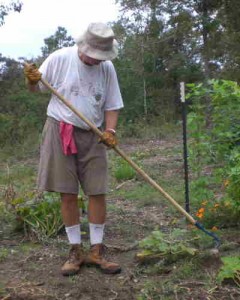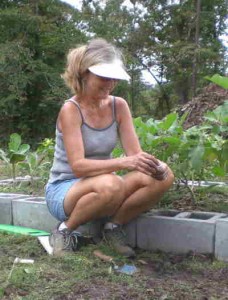The deer fence still isn’t in. But we’re forging ahead as if it were and planting our fall garden.
If you’re focused on providing as steady a source of food as possible on a subsistence farm in Alabama, you can grow prodigious quantities in the summer and spend the hottest months of the summer canning and freezing the excess for the fall and winter, you can grow in hoop houses, or you can learn to love a fall garden. We’ll probably do a little of all three, but the one we can get started learning about now is the fall garden.
It probably should have gone in before now, but doing things a little later than we should has been a continuing theme of our adjustment to farm life; why should this be different?
The deer get hungrier in the fall, because they find less of the fresh, succulent fruit and foliage they love in the forest, so the deer pressure on a fall garden is worse than that on a summer garden. Love that term “deer pressure,” such a nice reframe for Bambi snatching the food out of our months. My bride and I have developed an entirely different sensibility now about deer. Those adorably cute forest creatures we once loved to see frolicking while on our walks have transformed themselves, in one season’s garden feasting, into oversized rats that must be controlled if we are to survive.
But I digress. Plenty of time to address control later. Our focus for today is gardening, not fencing.
 The first order of the day was to deal with the weeds we had let play undisturbed for the past few weeks as our summer garden declined. Amanda prefers to pull weeds out with her hands, but I like working with our long weeding hoe. Rather than pull the weeds away and take them to the compost pile, I simply let them lie on top of the soil to act as mulch. Amanda’s concerned that they may take root again and continue tormenting us, and she may be right. But how are we going to find out for sure without trying it? I know from having the good folks at GardeningOrganically drill it into me that bare soil is a bad thing, so we needed to keep the soil covered with something.
The first order of the day was to deal with the weeds we had let play undisturbed for the past few weeks as our summer garden declined. Amanda prefers to pull weeds out with her hands, but I like working with our long weeding hoe. Rather than pull the weeds away and take them to the compost pile, I simply let them lie on top of the soil to act as mulch. Amanda’s concerned that they may take root again and continue tormenting us, and she may be right. But how are we going to find out for sure without trying it? I know from having the good folks at GardeningOrganically drill it into me that bare soil is a bad thing, so we needed to keep the soil covered with something.
The tomatoes aren’t quite finished, and the okra is still going strong, so we left both of these in place, along with the bell peppers and of course all the collards. Ditto the canteloupe and watermelon. By pulling out the summer squash, zucchini, and cucumber, however, and by putting all the desolate-looking corn stalks that were not providing climbing support for the beans, we created a nice little “field” in the garden. That’s where Amanda concentrated most of her planting.
We are nothing if not typical Americans. This means, among other things, that the best way to accomplish a task is to buy something. In our case, it’s seeds. We’re suckers for seeds. Petals from the Past, Seed Savers Exchange, Victory Seeds, we’re not particular. Just as long as Monsanto doesn’t own you, we’ll buy from you.
So before we planted anything, Amanda and I talked through the placement of our future bounty. How tall will broccoli plants get? Will the collards shade the brussel sprouts? Where will we need to walk to get to all of this, and how can we minimize foot traffic?
 Amanda muttered as she planted about how small all the seeds are. “It’s harder to plant these tiny little dark-colored seeds; they look just like the dirt.” While she planted, racing the predicted afternoon thundershowers, I worked on a new project, plant markers.
Amanda muttered as she planted about how small all the seeds are. “It’s harder to plant these tiny little dark-colored seeds; they look just like the dirt.” While she planted, racing the predicted afternoon thundershowers, I worked on a new project, plant markers.
Although our summer garden was bountiful, we struggled trying to remember what we had planted where. Yes, we had charted everything when we planted the first tranche, but my little hand-drawn diagram was not specific enough, and we kept adding things along the way. The result was a hopeless mish-mash, a few collards here, a fennel there, some basil and mint side by side with dill and some other plant we think was supposed to be attracting beneficials before I took it out by mistake.
With our fall garden, we hope to do better. We’ve been looking most of the year for commercially available plant markers. They tend to be either too flimsy or WAY too pricey for the volumes we need.
 When I asked Jeremy at Tallassee True Value for advice, he was kind enough to just give me some paint stirrers; I pulled down the radial arm saw to cut them in half and cut each one into a point, and we now have quite serviceable plant markers, basically for free. I printed labels for each one on the label maker, and we made sure the labels all face north to minimize sun damage. But we still don’t trust the labels in the weather, so I also took a Sharpie and wrote a number on the top of each marker. That number ties to a database we will maintain using Google Docs, and the database will be available to anyone interested in knowing our planting results.
When I asked Jeremy at Tallassee True Value for advice, he was kind enough to just give me some paint stirrers; I pulled down the radial arm saw to cut them in half and cut each one into a point, and we now have quite serviceable plant markers, basically for free. I printed labels for each one on the label maker, and we made sure the labels all face north to minimize sun damage. But we still don’t trust the labels in the weather, so I also took a Sharpie and wrote a number on the top of each marker. That number ties to a database we will maintain using Google Docs, and the database will be available to anyone interested in knowing our planting results.
Amanda kept planting as the sky turned darker, and the wind evolved from an almost imperceptible whisper to a whirling, gusty blast. Then it started to rain, each raindrop a massive water-bomb, and she kept planting. Finally, when I was about to go out and yank her in by the bra strap, she ran for cover under the barn, having planted most of our allotment for this project. We’ll finish another day.
Mr and Mrs Borden, I love the garden! I just wanted to suggest you check out the dollar spot at Target. I saw some plant markers there last week and almost got them. They appear to be aluminum that you can write on with a black marker. Might be worth a shot? Good luck!
Hi Danielle!
I think after you’re raising twins you’re entitled to call us Lee and Amanda, don’t you? Great to hear from you, and we’ll check out the markers at Target.